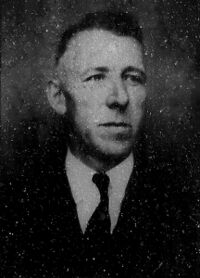Matthew John Lahr (1889-1960), Architect
Matthew John Lahr was born in Aurora, Illinois on June 13, 1889. He attended the Chicago Technology College from 1909-1915, during which time he worked for the firm, Pond & Pond, in Chicago. At the age of 25, Lahr attended the esteemed Columbia University School of Architecture, during which time, in 1916, Lahr started his own firm, Lahr & Stangel, in Omaha, Nebraska. From 1917-1919, Lahr served as a Master Engineer for the 491st Construction Squadron, and a year after this began a new firm, Ellert & Lahr, in Omaha. The partnership dissolved, and Lahr began working independently at his own firm, M.J. Lahr, until 1927. In 1927, Lahr once again partnered with Stangel, working together with him at their firm until 1941. It was at this time that Lahr, once again, worked on his own at the firm, M.J. Lahr, until 1960. Lahr was a member of the AIA throughout his career.
In his personal life, Lahr engaged in study travel throughout England, France, Italy, Germany, Belgium, Switzerland, Denmark, Spain, and Austria. Lahr became married in 1921, and with his wife he would eventually have four children.[3] Lahr died either February 2 or 3, 1960.[4][6][b]
This page is a contribution to the publication, Place Makers of Nebraska: The Architects. See the format and contents page for more information on the compilation and page organization.
Contents
Compiled Nebraska Directory Listings
Omaha, Nebraska, 1923-1925, 1938-1940, 1949, 1950-1956
Ralston, Nebraska, 1941-1948, 1956-1959
Educational & Professional Associations
1894-1903: student, Aurora, Illinois.[6]
1903-1906: student, Chicago Prep College, Chicago, Illinois.[6]
1906-1908: apprentice and rodman, general construction, William H. Graham, Chicago, Illinois.[6]
1908-1909: draftsman, William Arthur Bennett, Architect, Chicago, Illinois.[6]
1909-1916: draftsman, Pond & Pond, Architects, Chicago, Illinois.[3][6]
1910-1915: Chicago Technical College, architecture and engineering, Chicago, Illinois.[3][6]
1916: architect and partner, Lahr & Stangel, Architects, Omaha, Nebraska.
1916-1917: Columbia University, School of Architecture, New York, New York.[3][6]
1917-1919: master engineer, 491st Aero Construction Squadron, U.S. Army, France.[3][6]
1919-1920: architect and partner, Ellert & Lahr, Architects, Omaha, Nebraska.[3][6]
1920-1927: M. J. Lahr, Architect, Omaha, Nebraska.[3][6]
1928-1941: architect and partner, Lahr & Stangel, Omaha, Nebraska.[3][6]
1938: Registered Professional Architect, Nebraska, January 18, 1938, A-11. [6]
1941-1960: M. J. Lahr, Architect, Omaha and Ralston.[3]
1952-1956: City of Ralston, Planning Commission.[3]
Architectural Study Travel
England, France, Italy, Germany, Belgium, Switzerland, Denmark, Spain, Austria.[3]
Buildings & Projects
St. Rose School (1919), Omaha, Nebraska.[6]
St. Bridget’s Church (1923-1924), Omaha, Nebraska.[6]
Kay Apartments (1924), 118 N. 31st St., Omaha, Nebraska.[2] (DO09:0212-006)
Nottingham Apartments (1925), 3304 Burt, Omaha, Nebraska.[2][6] (DO09:0216-047)
Notre Dame Academy, First unit (1925), Omaha, Nebraska.[3][6]
Nottingham Apartments (1926), Omaha, Nebraska.[3]
Church (1926), Steinauer, Nebraska.[6]
Westphalia Grade and High School (1927), Westphalia, Iowa.[6][a]
Memorial Auditorium (1927), Nebraska City, Nebraska.[6][a]
High School (1929), Panama, Iowa.[6][a]
Auditorium and Gymnasium (1929), Earling, Iowa.[6][a]
Auditorium (1929-1931), Father Flanagan’s Boy’s Home, Omaha, Nebraska.[6][a]
Gymnasium (1929-1931), Father Flanagan’s Boy’s Home, Omaha, Nebraska.[6][a]
Swimming Pool (1929-1931), Father Flanagan’s Boy’s Home, Omaha, Nebraska.[6][a]
Administration Offices (1929-1931), Father Flanagan’s Boy’s Home, Omaha, Nebraska.[6][a]
Trades Building (1929-1931), Father Flanagan’s Boy’s Home, Omaha, Nebraska.[6][a]
Faculty Building (1929-1931), Father Flanagan’s Boy’s Home, Omaha, Nebraska.[6][a]
Service Building (1929-1931), Father Flanagan’s Boy’s Home, Omaha, Nebraska.[6][a]
Sacred Heart Church (1932), Shelby, Nebraska.[6][a]
Holy Cross School (1936), Omaha, Nebraska.[3][6][a]
Notre Dame Academy addition (1936-1937), Omaha, Nebraska.[6][a]
Auditorium and Gymnasium (1937), Neola, Iowa.[6][a]
Cox Apartments (1949), Omaha, Nebraska.[3]
Rorick Apartments (1950-1951), 604 S. 22nd, Omaha, Nebraska.[1][2][3] (DO09:0122-041)
Teachers Cooperative Apartments (1953), 122 S 39th, Omaha, Nebraska.[3] (DO09:0319-085)
Notes
a. Designed and supervised for Lahr & Stangel.[6]
b. Whereas reference [4] has the death date as February 2, 1960, reference [6] has it as February 3, 1960.
References
1. Landmarks, Inc., An Inventory of Historic Omaha Buildings (Omaha: City of Omaha and Landmarks Heritage Preservation Commission, 1980), 53.
2. City of Omaha Planning Department, Landmarks Heritage Preservation Commission, Database, Query on Architects, May 20, 2002; courtesy of Lynn Meyer, Preservation Planner.
3. American Institute of Architects, comp., American Architects Directory First Ed. (New York: R. R. Bowker Co., 1956), 315, accessed March 3, 2010, http://communities.aia.org/sites/hdoaa/wiki/Wiki%20Pages/1956%20American%20Architects%20Directory.aspx
4. “2 Ralstonites Die in Crash,” Omaha World-Herald (February 3, 1960), 20:3.
5. “Lahr,” Sunday World-Herald (February 7, 1960), 12B:2.
6. Application for Registration to Practice Professional Engineering and Architecture, Nebraska State Board of Examiners for Professional Engineers and Architects, October 31, 1937. Nebraska State Historical Society RG081 SG2.
Return to Top of Page
Page Citation
D. Murphy, “Matthew John Lahr (1889-1960), Architect,” in David Murphy, Edward F. Zimmer, and Lynn Meyer, comps. Place Makers of Nebraska: The Architects. Lincoln: Nebraska State Historical Society, February 9, 2015. http://www.e-nebraskahistory.org/index.php?title=Place_Makers_of_Nebraska:_The_Architects Accessed, December 17, 2025.
Contact the Nebraska State Historic Preservation Office with questions or comments concerning this page, including any problems you may have with broken links (see, however, the Disclaimers link at the bottom of this page). Please provide the URL to this page with your inquiry.
